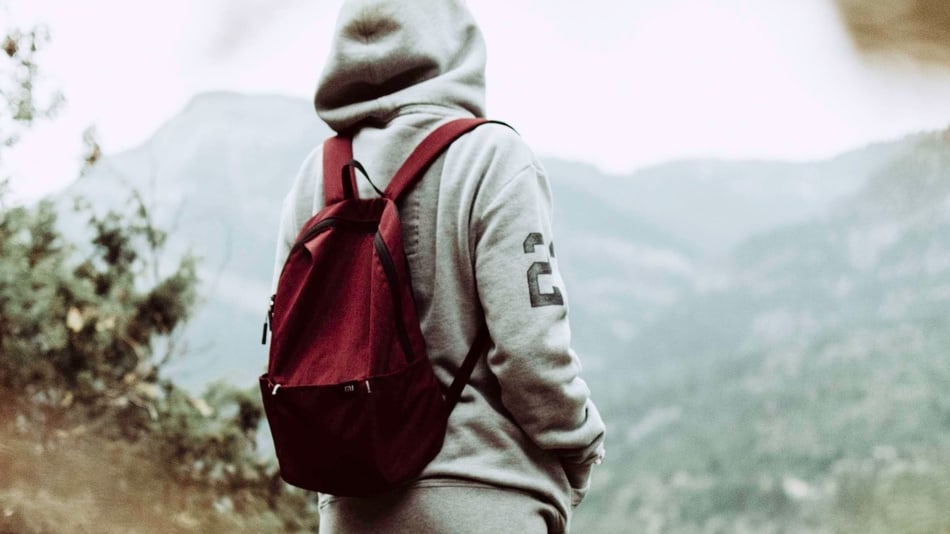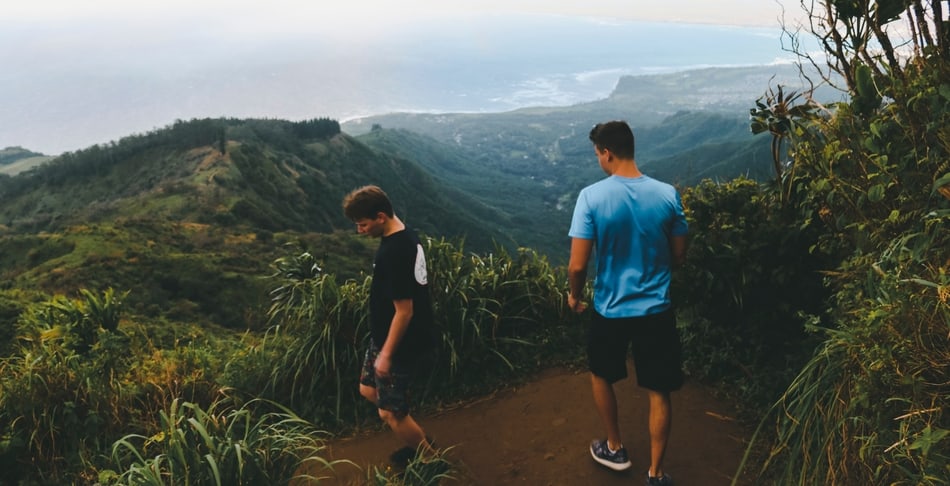
Comfort is essential when rappelling. Through years of experience and online research, I’ve created a comprehensive guide on what to wear while rappelling.
So, what do you want to wear on your rappels? The exact choices may change depending on the circumstances of your rappel, but loose-fitting articles of clothing that allow for lots of mobility usually makes for the best choices.
Dangling from a harness for extended periods of time can be uncomfortable enough without your clothes furthering the discomfort. By making the right choice when deciding what to wear, you can ensure that you get to enjoy your rappel and mitigate any injuries like rashes, sunburn, etc. Loose fitting clothing will make it easier for your harness to sit naturally, while mobility is important so that you can safely perform all the steps in your rappel.
Just a heads up: if your clothing is too loose-fitting, if may start getting in the way and get tangled in your rope. Try to avoid anything that’s so loose-fitting it may be considered baggy.
Shirts

When rappelling, your shirt can have two purposes (aside from keeping you decent): protecting you from the sun and stopping the harness from rubbing against your waist.
For protecting you against the sun, it’s up to personal preference if you want to wear a long sleeve or short sleeve shirt. Long sleeve will obviously make it easier to shield your arms, but you run the risk of overheating. T-shirts, by contrast, will keep you cool, but you may need to invest in some sunscreen if you burn easily.
Some clothes nowadays also come with SPF protection, which can be extra handy for shielding your skin.
For stopping the harness from rubbing against your waist, the most important thing is the length of the shirt. It should be long enough so that you can tuck it either a) into your shirt or b) underneath the belt of your harness, without having it pull loose when you move. This prevents you from developing a painful rash when the webbing of your harness rubs against exposed skin.
Rappelling isn’t the most exhausting thing on the planet, but it still counts as physical exercise. Because of that, it might be wise to avoid heavier materials such as cotton in exchange for something lighter. Outdoor clothing companies make a lot of money selling breathable, moisture-wicking shirts advertised for climbing and hiking. While these shirts will work for rappelling, they may not be worth the money; off-brand exercise clothes from a store like Winners can function just as well and save you a lot.
Note: When it’s extra hot outside, some people (myself included) may want to rappel shirtless (or in a sports bra, for the ladies). This is perfectly fine, as long as you’re aware that you won’t have protection from the sun, your waist might get chaffed, and you’re a little more prone to cuts and bruises if you bump in to the rock.
Sweaters/Jackets

For colder days, a sweater or jacket can be essential. These can usually slip on over your harness and keep you warm/dry when you’re suspended mid-air. Aside from just comfort, being warm can bring with it safety concerns as well. Cold, shivering and wet are not the type of conditions you want to be in when you’re doing through important safety procedures. Protecting you from the elements gives your mind more capacity to focus on what’s important— and because of that, coming prepared with a sweater or jacket is essential.
For this category, I would actually recommend the opposite in terms of length than what I said for a t-shirt. Shirts are often thin enough to tuck underneath your harness, while jackets can be bulkier and more difficult to manage. Because of this, bomber-style jacket— or any other style that’s shorter around the waist— will stop the hem from getting in the way of your rope and gear clips, while still keeping you warm.
Taking clothing on and off mid-rappel can be a massive pain (not to mention very dangerous). Because of this, it’s good to have a jacket with some kind of breathability or flaps that you can open should you start to overheat.
So, what type of sweater/jacket should you wear? Rain coats/windbreakers are always a good choice. They’re water and win proof, they pack small, and they often have back or armpit vents that can help you stay cool. When it comes to insulating from the cold, however, they can lack in effectiveness compared to something bulkier.
For summer months in warm climates, I would definitely say go with a rain jacket. When the weather starts to cool down, however, you may need something more substantial. Wool is an excellent choice for combining warmth with water-repellant features. It won’t stay 100% waterproof, but a good wool sweater— especially one that’s treated to wick moisture— can certainly hold its own against a light rain or mist.
Of course, if you’re really worried about the weather, layering up is always a good option. Pair a rain jacket with a nice fleece sweater to truly ensue that you’re insulated.
Pants/Shorts

The choice between pants and shorts is going to come down to a matter of preference and weather conditions.
Personally, I prefer pants. I find that they protect my legs better, and they don’t get as bunched-up as shorts do when I’m wearing a harness. A lot of people like to wear shorts, however, because of the increased breathability that they offer.
There is a hybrid choice in the form of zip-off pants, which provide the best of both worlds. For those of you who don’t know, these are a pair of pants with a zipped seam that allow you to remove the lower half of the legs and convert them in to a short. They’re great for when you’re in a situation with fluctuating temperatures and you can’t be bothered to carry around a spare pair of shorts and commit the time to change in to them.
I strongly, strongly recommend against trying to remove your pant legs mid-rappel. This can lead to a whole host of dangerous situations, and it’s really not worth the marginal change in temperature.
If you’re conducting a series of rappels, however, where you’re going to have time between to rest on solid ground, this can be a great option to avoid overheating. Another area where these can be useful is if you have a long approach to your rappel. Zip off the pants on the approach to stay cool while hiking, and then put them back on so that your legs stay protected when you’re rappelling.
In terms of material, this is one area where I think it’s appropriate to go out and buy a pair of climbing or hiking-specific pants. These are designed to be durable yet breathable, and comfortable when wearing a harness. Loose-fitting pants like tracksuits or sweats are a little too flexible and can move around a lot underneath your harness, while jeans tend to be stiff and inflexible. A good pair of hiking pants, however, are sturdy enough to maintain their shape while not being quite as unforgiving as jeans.
Shoes

This is an important one, because your feet can be essential to help you control yourself against whatever wall you’re rappelling down.
There’s a few things you want to consider when selecting a pair of shoes:
- Grip: The bottom of your soles have to have a sufficient grip to help you find control on whatever you’re rappelling down. The sole of the shoe should also be thick enough to protect your feet from sharp rocks and other hazards. In terms of grip, textured rubber found on hiking shoes or approach shoes is often the best alternative.
- Weight: Holding your legs up in a parallel position while rappelling can become tiring over extended periods of time. It becomes even more tiring if your feet are cased in a heavy pair of boots. A standard saying in hiking is ‘a pound on the foot is worth three on the back’. Put simply, this means that your body expends a lot of energy trying to keep your feet up, so there’s no point in making them work harder than necessary.
- Protection: Closed toes are a necessity when you’re rappelling. Sandals definitely have their place in the world, but working with hard stone and rockfall hazard is not the place for them. Make sure that your toes are sufficiently protected from getting crushed by investing in a good pair of shoes.
Based on the above criteria, a pair of hiking shoes, approach shoes, or trail runners are best to wear when rappelling. If you don’t want to have to splurge on a new pair, everyday runners will do just fine.
Rain Gear

I talked about rain jackets above, but its worth touching on it again here. There’s few things in this world less fun than getting caught in the rain when you’re dangling seventy feet up from a piece of rope (I should know— I’ve been there). This isn’t just uncomfortable; it’s also dangerous, because when you’re wet an uncomfortable, you’re more prone to rush and make a mistake. Because of this, it’s essential to come prepared with the appropriate gear.
Always check the forecast beforehand so you know what you need to bring to your rappel. If it’s calling for rain, make sure you pack your jacket, along with a pair of rain pants if you think it will be necessary.
Similar to rain jackets, rain pants are made of waterproof material and are designed to pull over what you’re already wearing so help and keep you dry. They have some obvious benefits, but they also come with the drawback of making your harness less comfortable and making it harder for your legs to breath. If left on in warm temperatures, they can quickly cause overheating.
Accessories

Aside from the main articles of clothing, there are a few other things you might want to consider wearing when you rappel:
Hats
Hats are great for increasing visibility and helping to keep the sun off of your face/neck. They can also prevent rain from getting in your eyes. I would highly recommend bringing a hat with you no matter what the weather conditions are.
The type of hat you want to wear comes down to personal preference. Wide-brimmed hats are more adept at keeping sun off the back of your neck, but they’re also harder to pack down, and if you’re wearing a backpack they can sometimes interfere with the brim. Baseball caps solve this problem, although they’re not as protective.
Another thing to consider is how secure your hat is on your head. Rappelling can expose you to some pretty strong winds, and you don’t want your favourite hat blowing away.
Sunglasses
Similar to above, sunglasses are important for ensuring good visibility when rappelling, which can affect safety and comfort. Same as the hats, you need to be aware that you’re at risk of dropping your sunglasses— investing in a band to keep it on your head can certainly be a good idea.
In terms of sunglass quality, it’s definitely going the extra mile to invest in a polarized pair. Some mountaineering companies offer wrap-around designs that protect you from all angles, but I personally don’t believe these are necessary.
Gloves
Rappelling gloves are a key piece of gear if you want to prevent painful blisters from occurring during long rappels. You can chose from several options, including fingered or fingerless gloves; the most important thing is that you find a pair that works for you.
If you don’t have a pair of rappel/belay gloves, it’s easy to substitute them for something less specialized. Everyday gardening gloves, especially ones made from some kind of buckskin, will perform perfectly well.
Socks
A good pair of socks can go a long way in helping your feet stay dry and comfy. The right socks can also turn an uncomfortable pair of shoes into something tolerable.
Wool socks are usually preferred because of their moisture-absorbing ability and breathability.
Packs

If you’re bringing lots of gear, having a pack to carry it all in is definitely a good thing. I wrote an article on rappelling with a backpack, so it’s worth a read to make sure you’re following all the appropriate safety steps.
When selecting a bag, look for something close-fitting, with enough straps that you can adjust it for comfort and hold it tight to your body. You don’t want your bag to be dangling around, because this is far less comfortable and will make it harder to prevent your gear from getting banged up. Climbing specific packs like the Mountain Hardwear MultiPitch will work the best, but anything with a chest and waist strap should perform just fine.
Sunscreen/Bug Spray
Sunscreen and bug spray can really increase the safety of your rappel, so it’s definitely worth bringing them along. A few things to consider:
- Waterproof sunscreen can help prevent you from sweating it off, or losing your protection if you go near a waterfall.
- Be careful bringing your sunscreen around your rope!! DEET is a damaging chemical, and exposing it to your gear can compromise the integrity of the equipment. When applying it, make sure to stand as far away from your rope as possible to prevent any contact.
Knee/Shoulder/Elbow Pads
These are less common, but they’re still useful so it’s worth a mention. If you’re trying to navigate through tricky terrain— say, a wet ledge in the middle of a canyon— you might want some additional protection for your body. Knee pads can be a lifesaver against hard rock, and they’re pretty commonly found in caving expeditions or canyoneering trips. You can buy climbing-specific gear or go with something more common, like volleyball pads.
Situational Awareness

I’ve tried to keep this list as broad as possible, because the situation in which you’re going to rappel will always differ. However, there are two explicit scenarios that I want to mention that will cause you to heavily modify what you’re wearing:
Waterfall Rappelling
When waterfall rappelling, everything becomes about dealing with moisture. Your clothes should be quick-dry and breathable. Your shoes should be lightweight and, if possible, water supportive— close-toed sandals are ideal.
In some cases, it may be worth investing in a wetsuit (if the water is going to be cold) or bringing a spare pair of clothes (if you have a long hike out— nothing is as demoralizing as needing to trek long distances in soggy clothes).
Cold Weather
Cold weather brings its own hosts of problems. Here, make sure to swap your baseball cap for a toque, ditch the shorts, and throw an extra layer in your bag.
The biggest change you’re going to need to make is gloves. It’s essential that you keep your hands warm while rappelling, so you can retain control of the rope and deal with all the gear that’s necessary. If need be, bring two pairs of gloves— one smaller one for working with knots and carabiners, one bulkier pair of mitts to keep your hands warm when sitting around.
Conclusion
So there you go! That’s my guide on what to wear while rappelling. If you have any thoughts please don’t be afraid to leave a comment below, and feel free to shoot me an email if you have any questions.
